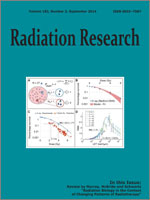DNA double-strand breaks (DSBs) induced by ionizing radiation pose a major threat to cell survival. The cell can respond to the presence of DSBs through two major repair pathways: homologous recombination (HR) and nonhomologous end joining (NHEJ). Higher levels of cell death are induced by high-linear energy transfer (LET) radiation when compared to low-LET radiation, even at the same physical doses, due to less effective and efficient DNA repair. To clarify whether high-LET radiation inhibits all repair pathways or specifically one repair pathway, studies were designed to examine the effects of radiation with different LET values on DNA DSB repair and radiosensitivity. Embryonic fibroblasts bearing repair gene (NHEJ-related Lig4 and/or HR-related Rad54) knockouts (KO) were used and their responses were compared to wild-type cells. The cells were exposed to X rays, spread-out Bragg peak (SOBP) carbon ion beams as well as with carbon, iron, neon and argon ions. Cell survival was measured with colony-forming assays. The sensitization enhancement ratio (SER) values were calculated using the 10% survival dose of wild-type cells and repair-deficient cells. Cellular radiosensitivity was listed in descending order: double-KO cells > Lig4-KO cells > Rad54-KO cells > wild-type cells. Although Rad54-KO cells had an almost constant SER value, Lig4-KO cells showed a high-SER value when compared to Rad54-KO cells, even with increasing LET values. These results suggest that with carbon-ion therapy, targeting NHEJ repair yields higher radiosensitivity than targeting homologous recombination repair.
How to translate text using browser tools
12 August 2014
Nonhomologous End-Joining Repair Plays a More Important Role than Homologous Recombination Repair in Defining Radiosensitivity after Exposure to High-LET Radiation
Akihisa Takahashi,
Makoto Kubo,
Hongyu Ma,
Akiko Nakagawa,
Yukari Yoshida,
Mayu Isono,
Tatsuaki Kanai,
Tatsuya Ohno,
Yoshiya Furusawa,
Tomoo Funayama,
Yasuhiko Kobayashi,
Takashi Nakano





